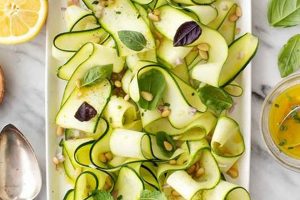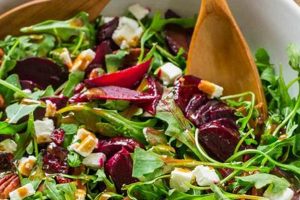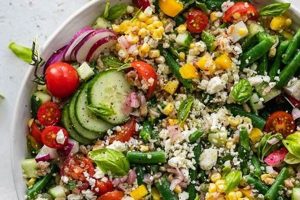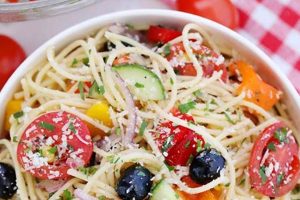Simple beet salads focus on accessibility and speed, minimizing complex procedures and ingredient lists. These recipes often feature pre-cooked beets, readily available dressings, and minimal chopping or preparation. An example might include canned beets, crumbled goat cheese, orange segments, and a simple vinaigrette.
The accessibility of these recipes makes them attractive to home cooks seeking nutritious and flavorful meals without extensive time commitments. Beets, rich in nitrates and antioxidants, offer numerous health benefits. The historical context of beet salads reveals their evolution from simple, boiled beet preparations to the diverse and vibrant variations seen today. This evolution reflects changing culinary trends and increased awareness of the nutritional value of root vegetables.
Exploring this culinary landscape, one discovers a variety of approaches to creating simple and satisfying beet salads, ranging from classic combinations to innovative pairings. The following sections will delve into specific techniques, ingredient selections, and variations to inspire both novice and experienced cooks.
Tips for Simple Beet Salads
Achieving a delicious and vibrant beet salad without extensive effort requires attention to a few key details. The following tips offer guidance for creating flavorful and visually appealing salads with minimal complexity.
Tip 1: Pre-cooked Beets Simplify Preparation: Utilizing pre-cooked and vacuum-packed beets significantly reduces preparation time. These can be found in most grocery stores and offer a convenient shortcut.
Tip 2: Embrace Canned Beets: Canned beets offer an even more convenient option, although rinsing them thoroughly is recommended to remove excess sweetness.
Tip 3: Balance Sweetness with Acidity: Beets possess a natural sweetness that benefits from a balancing acidic element. Citrus fruits, vinegars, or a touch of lemon juice complement the earthy flavor profile.
Tip 4: Textural Contrast Enhances Enjoyment: Incorporating contrasting textures elevates the salad. Crunchy nuts, creamy cheeses, or toasted seeds add depth and interest.
Tip 5: Simple Dressings Suffice: A simple vinaigrette often provides the perfect complement to beet salads. A blend of olive oil, vinegar, and a touch of Dijon mustard creates a balanced and flavorful dressing.
Tip 6: Consider Flavor Affinities: Beets pair well with a variety of flavors, including goat cheese, orange, walnuts, and dill. Experimenting with different combinations can lead to exciting discoveries.
Tip 7: Uniformity in Cutting Improves Presentation: Consistent slicing or dicing of the beets ensures even cooking (if roasting fresh beets) and creates a more visually appealing salad.
By employing these tips, one can create flavorful, healthy, and visually appealing beet salads without sacrificing valuable time or resorting to complex techniques. These strategies allow the natural flavors of the beets to shine while ensuring a satisfying culinary experience.
Equipped with these practical tips, one can confidently approach beet salad preparation, ensuring a successful and enjoyable outcome. The following section will offer concluding thoughts and further inspiration for exploring the versatility of this vibrant root vegetable.
1. Pre-cooked Beets
Pre-cooked beets represent a pivotal element in achieving simplified beet salad preparation. The availability of pre-cooked beets, whether vacuum-packed or canned, significantly streamlines the process, eliminating the need for lengthy roasting or boiling. This convenience factor directly contributes to the accessibility of beet salad recipes, making them a viable option for time-constrained individuals. The time saved translates into increased feasibility for incorporating nutritious beet salads into regular meal rotations. For instance, a weeknight meal can easily incorporate a beet salad if the beets are already cooked, allowing for quick assembly with other readily available ingredients.
Furthermore, the use of pre-cooked beets reduces the complexity often associated with preparing this root vegetable. Concerns about staining cutting boards or hands, as well as the potential mess of peeling and cooking beets, are mitigated. This simplification expands the appeal of beet salads beyond experienced cooks, encouraging culinary exploration by individuals with varying levels of kitchen proficiency. The predictable cooking time inherent in pre-cooked beets also ensures consistent results, removing a potential barrier for those less familiar with beet preparation. This reliability fosters confidence and encourages experimentation with different flavor combinations and salad components.
In conclusion, pre-cooked beets function as a crucial component in the evolution of beet salad recipes towards increased ease and accessibility. Their utilization addresses time constraints, simplifies preparation, and promotes culinary confidence, ultimately contributing to the wider adoption of beet salads as a healthy and convenient meal option. This convenience, however, requires careful consideration of flavor profiles, as pre-cooked beets can sometimes possess a slightly different taste than freshly roasted beets. Balancing these flavors through thoughtful ingredient pairings and dressings remains essential for achieving a delicious and satisfying salad.
2. Simple Dressings
Simple dressings play a crucial role in the accessibility and appeal of easy beet salad recipes. The inherent sweetness and earthy flavor of beets necessitate a balanced dressing that complements rather than overwhelms. Complex dressings with numerous ingredients or elaborate preparation methods can detract from the natural beet flavor and increase the overall complexity of the salad. Simple vinaigrettes, composed of a few high-quality ingredients like olive oil, vinegar, and perhaps a touch of Dijon mustard or honey, offer a harmonious counterpoint to the beet’s sweetness and earthiness. A lemon vinaigrette, for example, provides brightness and acidity, while a balsamic vinaigrette adds a touch of sweetness and depth. The simplicity of these dressings contributes directly to the “easy” aspect of the recipes, requiring minimal time and effort.
Furthermore, the simplicity of the dressing allows the flavor of the other salad components to shine. If the dressing is too complex or overpowering, the nuances of other ingredients, such as toasted nuts, crumbled cheese, or fresh herbs, might be lost. A light and balanced dressing enhances the overall flavor profile of the salad, allowing the individual components to contribute their unique characteristics. For instance, a salad with roasted beets, goat cheese, and walnuts benefits from a simple vinaigrette that allows the nuttiness of the walnuts and the tanginess of the goat cheese to complement the sweetness of the beets without being masked by a heavy or complicated dressing. This approach aligns with the goal of creating a delicious and satisfying salad with minimal effort.
In conclusion, the strategic use of simple dressings represents a key element in achieving the ease and flavor balance characteristic of successful beet salads. A simple vinaigrette not only complements the natural flavor of beets but also allows other ingredients to contribute to the overall sensory experience. This approach minimizes preparation time and complexity while maximizing flavor, aligning perfectly with the objective of creating accessible and enjoyable beet salad recipes. The choice of a simple dressing contributes significantly to the overall ease and appeal of these salads, making them an attractive option for cooks of all skill levels.
3. Minimal Ingredients
Minimal ingredients contribute significantly to the ease and accessibility of beet salad recipes. A streamlined ingredient list simplifies shopping, reduces preparation time, and minimizes potential complexities in the cooking process. The focus shifts to highlighting the natural flavor of the beets and a few carefully selected complementary ingredients. This approach aligns perfectly with the “easy” aspect of these recipes, making them attractive to individuals seeking quick, flavorful, and healthy meal options. For instance, a salad featuring pre-cooked beets, orange segments, crumbled goat cheese, and a simple vinaigrette requires only a handful of ingredients, each contributing distinct flavor and textural elements without overwhelming the palate. This minimalist approach contrasts with more complex salads involving numerous components and elaborate preparations.
The inherent simplicity derived from minimal ingredients allows for greater flexibility and creativity within the constraints of an easy recipe. Cooks can readily substitute ingredients based on personal preferences or availability without compromising the fundamental essence of the salad. Swapping goat cheese for feta, or oranges for grapefruit, demonstrates the adaptability of these recipes. Furthermore, the reduced number of ingredients simplifies the management of leftovers and minimizes food waste, a practical consideration for households seeking efficient meal planning. This efficiency further reinforces the connection between minimal ingredients and the overall ease of preparation associated with these beet salads.
In conclusion, the principle of minimal ingredients plays a pivotal role in the design and execution of easy beet salad recipes. This approach streamlines the cooking process, enhances the flavor profile of the core ingredients, and offers adaptability for individual preferences. By focusing on a few key components, these recipes maximize efficiency, minimize complexity, and contribute to a more accessible and enjoyable culinary experience, ultimately promoting the wider adoption of beet salads as a healthy and convenient meal option. This understanding of the importance of minimal ingredients provides a practical framework for creating simple, flavorful, and satisfying beet salads suitable for various skill levels and dietary preferences.
4. Quick Preparation
Quick preparation is a defining characteristic of easy beet salad recipes. The ability to assemble a nutritious and flavorful salad within a limited timeframe significantly impacts its appeal and practicality. This emphasis on speed and efficiency caters to the demands of modern lifestyles, where time constraints often dictate meal choices. The following facets explore the components and implications of quick preparation in the context of beet salad recipes.
- Pre-cooked Ingredients
Pre-cooked beets, whether canned or vacuum-packed, eliminate the most time-consuming aspect of traditional beet salad preparation. This convenience allows cooks to bypass the lengthy process of roasting or boiling fresh beets, significantly reducing overall preparation time. For example, using pre-cooked beets allows a salad to be assembled in minutes, as opposed to the hour or more required when starting with raw beets. This time-saving element directly contributes to the “easy” designation of these recipes.
- Simple Procedures
Easy beet salad recipes typically involve minimal chopping, slicing, or other complex culinary techniques. The focus remains on straightforward assembly rather than intricate preparation. For instance, combining pre-cooked, diced beets with crumbled cheese, pre-washed greens, and a simple vinaigrette requires only a few basic steps, minimizing time and effort. This streamlined approach contributes significantly to the quick preparation associated with these salads.
- Readily Available Ingredients
Easy beet salad recipes often utilize readily available ingredients commonly found in most kitchens or easily procured from local grocery stores. This accessibility minimizes shopping time and ensures that the necessary components are readily at hand. The use of common ingredients like canned beets, bagged greens, and pantry staples like olive oil and vinegar further streamlines the process, contributing to the quick and effortless nature of these recipes. This reliance on accessible ingredients underscores the practicality and convenience of these salads.
- Minimal Cooking Time
Beyond the utilization of pre-cooked beets, easy beet salad recipes minimize active cooking time. Simple dressings typically require whisking a few ingredients together, and any additional components, such as toasted nuts or seeds, often require only a brief period of toasting. This minimal cooking time, coupled with the use of pre-prepared ingredients, ensures that the entire salad can be assembled and ready to serve within minutes, maximizing efficiency and convenience. This characteristic aligns perfectly with the emphasis on speed and simplicity.
These facets of quick preparation collectively contribute to the ease and accessibility of beet salad recipes. By streamlining the process and minimizing time investment, these recipes empower individuals to incorporate nutritious and flavorful salads into their meals, even with demanding schedules. The emphasis on speed and simplicity does not compromise the potential for culinary creativity, as demonstrated by the wide variety of flavor combinations and ingredient pairings possible within the framework of quick-preparation beet salads. The convergence of these factors establishes easy beet salad recipes as a practical and appealing choice for health-conscious individuals seeking convenient meal solutions.
5. Versatile Flavor Pairings
Versatile flavor pairings represent a cornerstone of “beet salad recipes easy.” The inherent earthiness and sweetness of beets provide a robust foundation for a wide spectrum of complementary flavors, facilitating diverse and exciting culinary experiences without demanding complex preparation. This versatility directly contributes to the “easy” aspect by empowering cooks to utilize readily available ingredients and personalize recipes based on individual preferences or dietary restrictions. For example, the classic combination of beets, goat cheese, and walnuts exemplifies a balanced flavor profile, where the tanginess of the goat cheese and the richness of the walnuts harmonize with the beet’s sweetness. However, this versatility extends far beyond the classic pairings. Citrus fruits, such as oranges or grapefruit, introduce a refreshing acidity that cuts through the beet’s earthiness. Similarly, pungent cheeses like feta or blue cheese offer a bold counterpoint to the beet’s sweetness. The adaptability of beets to various flavor profiles simplifies recipe creation and reduces reliance on specialized ingredients, aligning with the core principle of ease.
This inherent versatility translates into practical benefits for both novice and experienced cooks. The ability to substitute ingredients based on availability or personal preference reduces the barrier to entry for those new to beet salads. Furthermore, the wide range of complementary flavors allows for continuous exploration and innovation, preventing culinary monotony. A simple beet salad can be transformed with the addition of toasted nuts, dried cranberries, or fresh herbs, demonstrating the potential for customization within the framework of an easy recipe. This adaptability extends to dressings as well, where simple vinaigrettes can be infused with diverse flavors ranging from citrus zest to Dijon mustard. The ease with which these variations can be implemented reinforces the connection between versatile flavor pairings and the overall simplicity of these recipes. This aspect contributes to the long-term appeal of beet salads, ensuring continued enjoyment and exploration within a framework of ease and accessibility.
In summary, the versatility of beet flavor pairings stands as a defining characteristic of “beet salad recipes easy.” This adaptability simplifies ingredient selection, promotes culinary creativity, and ensures consistent enjoyment. By understanding the interplay of flavors and textures that complement the inherent qualities of beets, cooks can confidently create diverse and satisfying salads with minimal effort. This versatility ultimately contributes to the broader goal of making healthy and delicious meals readily accessible to a wide audience, regardless of culinary expertise or time constraints. The exploration of diverse flavor pairings within the context of “beet salad recipes easy” fosters culinary confidence and encourages a deeper appreciation for the versatility of this nutritious root vegetable.
6. Accessible Techniques
Accessible techniques are integral to the concept of “beet salad recipes easy.” Ease of preparation relies heavily on techniques requiring minimal specialized equipment, advanced culinary skills, or extensive time commitments. The accessibility of these techniques broadens the appeal of beet salads, enabling individuals with varying levels of culinary experience to create delicious and nutritious meals. A reliance on straightforward procedures, such as basic knife skills for chopping or slicing, and fundamental cooking methods like boiling or roasting (if using fresh beets), ensures that the recipes remain manageable and achievable for a wider audience. For example, a recipe utilizing pre-cooked beets eliminates the need for advanced roasting techniques or specialized equipment like mandolines, thereby simplifying the process and making it accessible to a larger demographic. This accessibility promotes culinary confidence and encourages experimentation with different flavor combinations and ingredient pairings. The emphasis on accessible techniques directly correlates with the overall ease and simplicity that define these recipes.
The practical significance of accessible techniques extends beyond individual empowerment. These techniques contribute to greater efficiency in meal preparation, aligning with the demands of busy lifestyles. The ability to create a nutritious and flavorful salad without resorting to complex procedures or specialized tools simplifies weeknight meal planning and reduces reliance on processed foods. Furthermore, accessible techniques often promote healthier eating habits by encouraging the consumption of fresh produce and minimizing the need for pre-packaged or processed ingredients. For instance, a simple vinaigrette made with olive oil, vinegar, and a touch of Dijon mustard requires minimal technical skill yet provides a far healthier alternative to commercially produced dressings often laden with additives and preservatives. This emphasis on accessible techniques fosters a positive feedback loop, encouraging culinary engagement and promoting healthier dietary choices.
In summary, accessible techniques form a critical foundation for “beet salad recipes easy.” The emphasis on simplicity and ease of execution empowers individuals to create flavorful and nutritious meals without requiring advanced culinary skills or specialized equipment. This accessibility promotes healthier eating habits, streamlines meal preparation, and fosters culinary confidence. By prioritizing accessible techniques, these recipes successfully bridge the gap between culinary aspiration and practical execution, making healthy and delicious beet salads a readily achievable component of a balanced diet. The continued focus on accessibility remains essential for expanding the appeal of beet salads and promoting their integration into diverse culinary landscapes.
7. Nutrient-Rich Options
Nutrient-rich options are a key consideration within the context of “beet salad recipes easy.” The nutritional value inherent in beets and their complementary ingredients contributes significantly to the appeal of these salads. Easy preparation does not necessitate a compromise on nutritional content. This section explores how “beet salad recipes easy” can deliver both convenience and a wealth of essential nutrients.
- Beets: Nutritional Powerhouse
Beets provide a rich source of nitrates, which convert to nitric oxide in the body, promoting improved blood flow and potentially lowering blood pressure. They are also a good source of folate, manganese, potassium, and fiber. The presence of these nutrients elevates simple beet salads from a mere side dish to a valuable component of a healthy diet. For example, a salad featuring roasted beets, walnuts, and goat cheese provides a combination of nitrates, healthy fats, and protein, contributing to a nutritionally balanced meal. The ease of preparation further encourages regular consumption of these beneficial nutrients.
- Complementary Ingredients: Enhancing Nutritional Value
The inherent nutritional value of beets can be further amplified through strategic ingredient pairings. Leafy greens, such as spinach or arugula, add vitamins A and C, while nuts and seeds contribute healthy fats and protein. Citrus fruits, often included for their flavor-balancing acidity, provide a boost of vitamin C and antioxidants. These additions create a synergistic effect, combining the nutritional benefits of multiple ingredients within a simple and easy-to-prepare salad. For example, adding a handful of walnuts to a beet and goat cheese salad enhances its omega-3 fatty acid content, further increasing its nutritional value. The simplicity of these additions aligns with the overall ease of the recipes.
- Nutrient Retention through Minimal Processing
The “easy” aspect of these recipes often translates to minimal processing of ingredients. Pre-cooked beets retain a significant portion of their nutrients, and the use of fresh ingredients like leafy greens, nuts, and citrus fruits ensures optimal nutrient intake. Minimal cooking times and simple dressings further contribute to nutrient preservation. This focus on minimal processing aligns with health-conscious dietary practices that prioritize whole, unprocessed foods. For instance, a simple lemon vinaigrette preserves the vitamin C content of the lemon juice more effectively than a complex, heat-processed dressing might. The ease of preparation therefore indirectly contributes to higher nutrient retention.
- Adaptability for Dietary Needs
“Beet salad recipes easy” are inherently adaptable to various dietary needs. The simplicity of these recipes allows for substitutions and omissions to accommodate allergies, intolerances, or specific dietary preferences. For example, individuals following a vegan diet can easily substitute dairy-based cheeses with plant-based alternatives, maintaining the nutritional benefits while adhering to their dietary restrictions. This adaptability ensures that the nutritional advantages of beet salads are accessible to a wider range of individuals, regardless of their dietary requirements. The ease with which these adjustments can be made reinforces the practical value of these recipes.
In conclusion, “beet salad recipes easy” represent a powerful intersection of convenience and nutritional value. The focus on simple preparation techniques and readily available ingredients does not compromise the potential for creating nutrient-rich meals. By understanding the nutritional contributions of beets and their complementary ingredients, individuals can leverage these recipes to create meals that support both their health and busy lifestyles. The adaptability and ease of these recipes position them as valuable tools for promoting healthy eating habits within a framework of convenience and accessibility.
Frequently Asked Questions
This section addresses common inquiries regarding simple beet salad recipes, providing concise and informative responses to clarify potential uncertainties and enhance understanding of this culinary topic.
Question 1: Can canned beets be used in easy beet salad recipes?
Canned beets offer a convenient shortcut for easy beet salad recipes. Rinsing canned beets thoroughly before use helps remove excess sweetness.
Question 2: How can the earthy flavor of beets be balanced in a salad?
The earthiness of beets is often balanced with acidic ingredients like citrus fruits (orange, lemon, grapefruit), vinegars (balsamic, red wine, apple cider), or a touch of lemon juice. These acidic elements complement the sweetness and earthiness of beets, creating a more balanced flavor profile.
Question 3: What are some simple dressing options for easy beet salads?
Simple vinaigrettes are ideal for easy beet salads. A basic vinaigrette consists of olive oil, vinegar (such as balsamic, red wine, or apple cider), and a touch of Dijon mustard or honey for added flavor complexity. These dressings complement the beets without overpowering other ingredients.
Question 4: How can texture be incorporated into easy beet salad recipes?
Textural contrast enhances the enjoyment of beet salads. Toasted nuts (walnuts, pecans, pistachios), crumbled cheese (goat cheese, feta, blue cheese), or toasted seeds (sunflower, pumpkin) provide satisfying crunch and contrast to the softer texture of beets.
Question 5: How long can a prepared beet salad be stored?
Refrigeration in an airtight container extends the shelf life of prepared beet salads. Generally, these salads can be stored for up to three to five days without significant flavor or texture degradation. However, it is essential to consider the shelf life of individual ingredients, such as leafy greens, which may wilt more quickly.
Question 6: What are some suitable alternatives to goat cheese in beet salads?
Feta cheese, blue cheese, or even ricotta salata offer viable alternatives to goat cheese. These cheeses provide different flavor profiles and textures, allowing for customization based on personal preferences. Plant-based cheeses can be substituted for a vegan option.
Understanding these commonly addressed questions helps ensure successful and enjoyable preparation of simple beet salads. The focus on ease of preparation does not compromise flavor or nutritional value, offering a practical approach to healthy and delicious meal creation.
The next section will offer concluding thoughts and recipe suggestions to inspire culinary exploration of easy beet salads.
Simple Beet Salad Recipes
Exploration of simple beet salad recipes reveals the accessibility of nutritious and flavorful meals through streamlined techniques and readily available ingredients. Pre-cooked beets, minimal ingredient lists, and simple dressings minimize preparation time without compromising flavor or nutritional value. The versatility of beet pairings, from classic goat cheese and walnut combinations to innovative additions like citrus segments and toasted seeds, demonstrates the adaptability of these recipes to diverse palates and dietary preferences. Accessible techniques further democratize beet salad preparation, empowering individuals of all culinary skill levels to create healthy and satisfying meals. The emphasis on minimal processing and nutrient-rich ingredients aligns with contemporary health-conscious trends, positioning simple beet salads as a valuable component of a balanced diet.
The ease of preparation associated with these recipes should not be misconstrued as a limitation on culinary creativity. Rather, it serves as a foundation for exploration and innovation, encouraging experimentation with diverse flavors, textures, and presentations. Simple beet salad recipes represent a gateway to incorporating nutrient-rich ingredients into everyday meals, promoting both culinary enjoyment and healthful eating habits. The continued evolution of these recipes promises further exploration of flavor profiles and culinary techniques, ensuring the enduring appeal of this versatile root vegetable in the culinary landscape.






